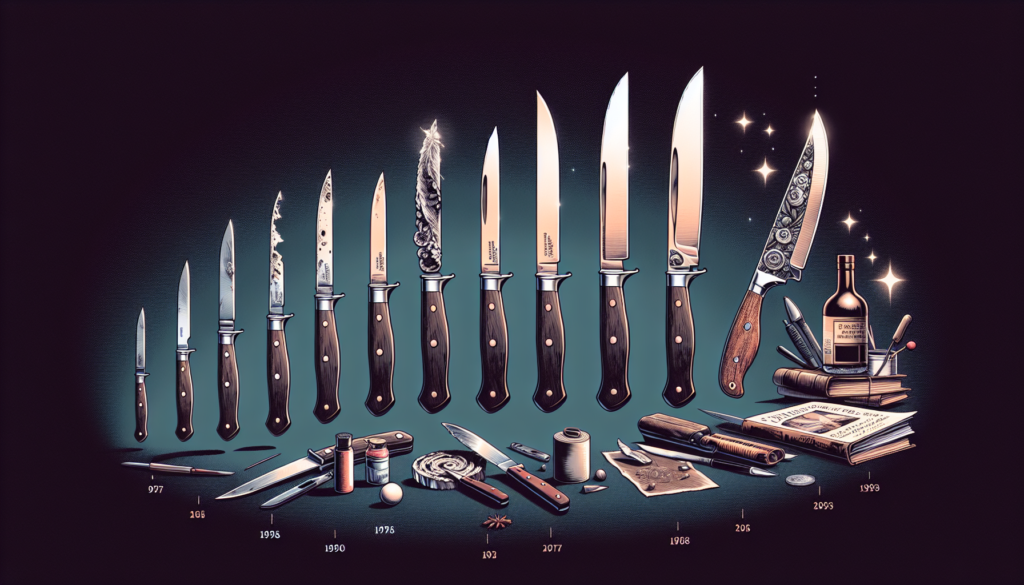Did you ever wonder if your trusty kitchen knives will eventually wear out? Well, you’re not alone! Many people ponder this question, as kitchen knives are an essential tool in any kitchen. From slicing vegetables to carving roast, a sharp and reliable knife is invaluable. In this article, we will explore the lifespan of knives and whether they do, in fact, wear out over time. So, grab a cup of tea and get ready to delve into the fascinating world of kitchenknife durability!

Factors That Affect your kitchen Knives Lifespan
Blade Material
The blade material is one of the most crucial factors that determine the lifespan of a knife. Different materials have varying degrees of hardness, corrosion resistance, and durability. LItchen knives made from high-quality stainless steel, for example, tend to have longer lifespans compared to those made from lower-grade materials. When choosing a knife, consider the purpose for which it will be used and opt for a blade material that is suitable for that specific task.
Frequency of Use of Kitchen Knives
How often you use a knife plays a significant role in its overall lifespan. Constant use will naturally wear down the blade over time, no matter how high-quality the material is. However, this doesn’t mean you should shy away from using your knives. With proper maintenance and care, even regularly used knives can have a long lifespan.
Maintenance
Regular maintenance is essential for extending the lifespan of your knives. This includes routine cleaning after each use, ensuring that the blade is dry to prevent rust and corrosion, and occasional oiling to maintain optimal performance. Additionally, regular honing and sharpening of the blade is necessary to keep its edge sharp and prevent excessive wear. Neglecting proper maintenance can significantly reduce the lifespan of your knives.
Quality of Construction
The quality of construction directly affects a knife’s lifespan. A well-constructed knife is more likely to withstand the test of time compared to a poorly made one. Pay attention to the handle attachment, blade-to-handle transition, and the overall balance of the knife. Investing in knives with solid construction and reliable craftsmanship will ensure that they last longer and perform better.
The Durability and Longevity of Cast Iron Pans
Storage
Proper storage is another factor that can either prolong or shorten the lifespan of your knives. Storing knives loosely in a drawer can lead to unnecessary wear and tear, as the blades can knock against other utensils. It is advisable to use a knife block or a knife magnet to hold the blades securely in place. If space is limited, blade guards or knife rolls can also protect the blades from potential damage. By storing knives properly, you can reduce the risk of accidents and extend their lifespan.
Sharpening
Regular sharpening is crucial for maintaining the longevity of your knives. As blades become dull with use, they require sharpening to restore their sharpness and slicing ability. However, it’s important to use the correct sharpening techniques to avoid over-sharpening or damaging the blade. Learning the proper skills or seeking the services of a professional sharpener will help ensure that your knives are sharpened effectively and maintain their optimal performance for an extended period.
Signs of Wear on Knives
Blunting
One of the most evident signs of wear on a knife is blunting, where the blade loses its sharpness and struggles to cut through objects. Blunting can occur over time due to the repeated use of the knife, particularly on hard surfaces or when cutting through dense materials. If you find yourself using more force than usual while cutting, it may be a sign that your knife is starting to blunt and requires sharpening.
Chips and Nicks
Chips and nicks on the blade can occur due to accidental impact or contact with hard materials. These imperfections can compromise the knife’s cutting ability and also present a safety hazard. When chips or nicks become significant, it may be necessary to retire the knife, as they can be difficult to repair effectively without altering the knife’s balance or functionality.
Corrosion
Corrosion is a common issue, particularly with knives made from carbon steel or lower-quality stainless steel. Exposure to moisture, acidic foods, or inadequate drying can lead to corrosion, resulting in pitting and discoloration on the blade. While minor corrosion can be removed through cleaning and polishing, severe corrosion may require professional intervention or the retirement of the knife to prevent further damage.
Loose Handles
The handle of a knife greatly impacts its functionality and safety during use. Over time, the constant pressure and wear can cause the handle to become loose or develop cracks. A loose handle can compromise your grip and potentially lead to accidents. If you notice any signs of handle damage, it’s essential to address the issue promptly. Handles that cannot be securely tightened or repaired may require the retirement of the knife.
The Durability and Longevity of Cast Iron Pans
Bent Blades
Bent blades are typically the result of excessive force or accidental bending during use. A bent blade not only hampers the knife’s cutting efficiency but can also pose safety risks. Minor bends can sometimes be corrected through careful straightening, but significant bends may render the knife irreparable. It’s essential to assess the severity of the bend and consider the potential risks before deciding whether to retire the knife.
Extending the Lifespan of Knives
Choosing the Right Blade Material
Choosing the appropriate blade material for your specific needs is crucial for maximizing the lifespan of your knives. Different materials have varying levels of hardness and corrosion resistance. For instance, carbon steel blades may require more maintenance to prevent rust, while stainless steel blades are typically more durable and corrosion-resistant. Consider the tasks you frequently perform in the kitchen, the knife’s intended purpose, and your personal maintenance preferences when selecting the blade material.
Proper Handling and Storage
Proper handling and storage techniques play a significant role in prolonging the lifespan of your knives. Always use a cutting surface that is ideal for the knife, such as a wooden or plastic board, to minimize unnecessary wear on the blade. Avoid cutting on hard surfaces like glass or stone, as they can cause chips or dull the edge. Additionally, store knives in a suitable storage solution to protect the blades from external impacts and ensure they stay dry and corrosion-free.
Regular Maintenance
Regular maintenance is key to maintaining the lifespan of your knives. Clean your knives immediately after use to remove any food residues and acids that may cause corrosion. Dry the blades thoroughly before storing them to prevent moisture buildup. Periodically oil the blade to protect it from rust, especially if you live in a humid environment. Regularly hone the blade to keep its edge sharp, and consider professional sharpening when necessary. By incorporating these maintenance practices into your routine, you can significantly extend the lifespan of your knives.
Sharpening Techniques
Proper sharpening techniques are vital for keeping your knives in optimal condition. It is essential to understand the angle and pressure required for sharpening, as well as the appropriate tools for the specific blade material. Whether you choose to use a sharpening stone, honing rod, or other specialized sharpening devices, ensure that you follow the instructions carefully to avoid damaging the blade. Regularly sharpening your knives will not only improve their performance but also extend their lifespan by preventing excessive wear from dull blades.
When to Retire a Knife
Irreparable Damage
If a knife has sustained irreparable damage, it may be time to retire it. Irreparable damage can include extensive chips or nicks that compromise the cutting edge, severe corrosion that has eaten into the blade, or a bent blade that cannot be safely straightened. Continuing to use a knife with irreparable damage can pose safety risks and hinder its functionality.
Repeated Sharpening
While sharpening is necessary for maintaining a knife’s cutting edge, repeated sharpening over an extended period can lead to a reduction in the blade’s overall lifespan. Over-sharpening can result in a thinner blade, making it more prone to chips and nicks. If you find yourself sharpening your knife frequently, it might be time to consider retiring it and investing in a new one.
Loss of Functionality
When a knife loses its functionality and no longer performs its intended tasks effectively, it may be time to retire it. This could manifest as a noticeable decrease in cutting efficiency, difficulty in maintaining a sharp edge, or a loose handle that compromises your grip. As knives age and experience wear, they may become less reliable and efficient in the kitchen, making it necessary to replace them for optimal performance.
The Durability and Longevity of Cast Iron Pans
Safety Concerns
If a knife poses a safety concern, it is best to retire it promptly. Signs of safety concerns can include loose or damaged handles, significantly bent blades, or a blade that unexpectedly detaches from the handle. Using a knife with safety hazards can lead to accidents and potential injuries. Prioritizing your safety and that of others is crucial, and retiring a knife exhibiting safety concerns is the responsible choice.

Conclusion
The lifespan of kitchen knives is influenced by several key factors. Blade material, frequency of use, maintenance, quality of construction, storage, and sharpening all play significant roles in determining how long a knife will last.
By understanding these factors and implementing proper care and maintenance techniques, you can effectively extend the lifespan of your knives. Regular maintenance, the use of appropriate storage solutions, and proper sharpening techniques will not only prolong the knife’s lifespan but also ensure optimal performance and safety throughout its usage.
However, there may come a time when a knife no longer serves its purpose due to irreparable damage, repeated sharpening, loss of functionality, or safety concerns. In such cases, it is essential to retire the knife and consider investing in a new one to continue enjoying the benefits of a reliable and effective kitchen tool.


